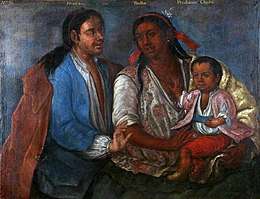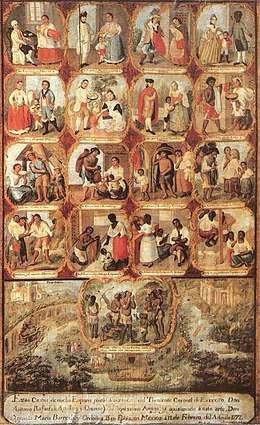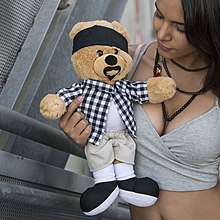Cholo
Cholo (Spanish pronunciation: [ˈtʃolo]) is a loosely defined Spanish term that has had various meanings. Its origin is a somewhat derogatory term for people of mixed-blood heritage in the Spanish Empire in Latin America and its successor states as part of castas, the informal ranking of society by heritage. Cholo no longer necessarily refers only to ethnic heritage, and is not always meant negatively. Cholo can signify anything from its original sense as a person with one Amerindian parent and one Mestizo parent, "gangster" in Mexico, an insult in some South American countries (similar to chulo in Spain), or a "person who dresses in the manner of a certain subculture" in the United States as part of the cholo subculture.[1][2]


Historical usage
The term's use is first recorded in a Peruvian book published in 1609 and 1616, the Comentarios Reales de los Incas by Inca Garcilaso de la Vega. He writes (in Spanish) "The child of a Black male and an Indian female, or of an Indian male and Black female, they call mulato and mulata. The children of these they call cholos. Cholo is a word from the Windward Islands; it means dog, not of the purebred variety, but of very disreputable origin; and the Spaniards use it for insult and vituperation".[3]
In Ecuador, mestizas wearing indigenous attire in Ecuador were termed cholas. "Chola appears to have been a designation largely reserved for women and which, according to Jacques Poloni-Simard, was used to indicate mestiza women who had achieved an incipient degree of hispanization that was beyond the grasp of men, who were more firmly bound to their native communities by tribute obligations."[4][5]
In Colonial Mexico, the terms cholo and coyote co-existed, indicating mixed Mestizo and Amerindian ancestry. Under the casta designations of colonial Mexico, the term rarely appears; however, an eighteenth-century casta painting by Ignacio María Barreda shows the grouping Español, India, with their offspring a Mestizo or Cholo[6]
Cholo as an English-language term dates at least to 1851 when it was used by Herman Melville in his novel Moby-Dick, referring to a Spanish speaking sailor, possibly derived from the Windward Islands reference mentioned above. Isela Alexsandra Garcia of the University of California at Berkeley writes that the term can be traced to Mexico, where in the early part of the last century it referred to "culturally marginal" mestizos and Native American origin.[7]
During the War of the Pacific (1879–1883) Peruvians were contemptuously referred to as "cholos" by Chilean officers.[8]
An article in the Los Angeles Express of April 2, 1907, headlined "Cleaning Up the Filthy Cholo Courts Has Begun in Earnest", uses the terms cholos and Mexicans interchangeably.[9] The term cholo courts was defined in The Journal of San Diego History as "sometimes little more than instant slums as shanties were strewn almost randomly around city lots in order to create cheap horizontal tenements."[10]
Modern usage
United States
Cholos, cholas and cholitas are used as informal slang terms in parts of the US, to refer to people of Mexican descent, who usually are low-income, "tough", and may wear stereotypical clothes.[2] The origin is complex:
Racial and cultural status, along with social class are reflected in the term cholo itself, which was adopted in California in the 1960s by youth following the pachuco tradition, as a label for that identity (Cuellar 1982). In 1571, Fray Alonso de Molina, in his Nahuatl vocabulary (Vocabulario en Lengua Castellana y Mexicana Y Mexicana y Castellana), defined the word xolo as slave, servant, or waiter. The Porrúa Dictionary defines cholo, as used in the Americas, as a civilized Native American or a half-breed or mestizo of a European father and Native American mother. The word has historically been used along the borderland as a derogatory term to mean lower class Mexican migrants, and in the rest of Latin America to mean an acculturating Indian or peasant.[11]
Despite, or because of, its long history of denigrating semantics, the term Cholo was turned on its head and used as a symbol of pride in the context of the ethnic power movements of the 1960s.[12]
Criminalization
Chicano/a youth who adopt a cholo or chola culture endure hyper-criminalization,[13] since police and institutions equate cholo style with a criminal style.[14] Educational institutions and the police "translate cholo as 'gang member'."[14] While older residents in barrios initially embraced cholas and cholos as "a larger subculture not necessarily associated with crime and violence (but rather with a youthful temporary identity), law enforcement agents, ignorant or disdainful of barrio life, labeled youth who wore clean white tennis shoes, shaved their heads, or long socks, as deviant."[13] Convinced by the police and schools of cholo/a criminality, some community members shamed and policed cholos and cholas, "reminiscent of the criminalization of Chicana and Chicano youth during the Zoot-Suit era in the 1940s."[13]
Sociologist José S. Plascencia-Castillo refers to the barrio as a panopticon–a space which leads to intense self-regulation–as cholo/a youth are scrutinized by police to "stay in their side of town" and by the community who sometimes "call the police to have the youngsters removed from the premises."[13] The intense governance of cholo/a identity has deep implications on youth experience, sometimes affecting their physical and mental health as well as their outlook on the future. Some cholo/a youth feel they "can either comply with the demands of authority figures, and become obedient and compliant, and suffer the accompanying loss of identity and self-esteem, or adopt a resistant stance and contest social invisibility to command respect in the public sphere."[13]
Fashion stereotypes

During the 1930s and 1940s, Cholos and Chicanos were known as pachucos and were associated with the zoot suit and hep cat subcultures.[15] The press at the time accused the pachucos in the U.S. of gang membership and petty criminality, leading to the Zoot Suit Riots.[16] Continuing until the early 1970s, the typical Cholo and Chicano hairstyle was a variant of the pompadour, piled high on the head and kept in place with large quantities of wet look gel.
.jpg)
In the 21st century, a cholo is stereotypically male, depicted as wearing loose fitting khaki pants or shorts, with white knee-high socks, creased jeans, white tank top undershirt, and button-front shirts, commonly plaid and flannel, often with just the top button buttoned. Cholos in the 1990s and 2000s frequently have their hair buzzed very short, though some continue to have the more traditional slicked-back hair, sometimes held in place by a hairnet or a bandana.
Footwear originally included Stacy Adams dress shoes, and "biscuits" (pointy toed dress shoes). Modern cholos tend to wear athletic shoes, such as Converse, Nike Cortez, Nike Air Force 1, Vans, Fila, Adidas Stan Smith, Onitsuka Tiger slip-on house shoes, K Swiss or Huarache sandals. Popular "Cholo" brands include Dickies, Ben Davis, Joker, Lowrider, and Bighouse.
Some cholos, particularly older cholos (veteranos) or cholos wishing to adopt a more traditional look, wear formal wear inspired by zoot suit fashion, including dress shirts with suspenders, and fedora hats, but may still retain cholo elements such as a bandana or hair net. In South Texas, cholos are sometimes referred to as chucs or chukes. This term is short for pachucos. Tejano cholos typically make heavy use of starch on their pants but so do traditional Tejanos.
This designation may also be associated with black ink tattoos, commonly involving calligraphy and art. A cholo might also stereotypically own a lowrider. Another staple of cholo fashion is long hair tied into braids as depicted by actor Danny Trejo.
Bolivia
In Bolivia, "cholo" refers to people with various degrees of Amerindian racial ancestry.[2] In Bolivia, the term "cholita" has overcome former prejudice and discrimination, and cholitas are now seen as fashion icons.[2] A "cholo" in Bolivia is a campesino who moved to the city, and though the term was originally derogatory, has become more of a symbol of indigenous power. The word "cholo/a" is considered a common and/or official enough term in Bolivia such that "cholo" has been included as its own ethnic group option in demographic surveys conducted in the country. In these same surveys, the term had on occasion been used interchangeably with the term "mestizo."[17] Nevertheless, some locals still use cholo as a derogatory term.
Ecuador
Cholos pescadores are a group of traditional fishermen along the coasts of Ecuador.
Peru
In Peru, Mestizos with greater Amerindian contributions (Indo-mestizo), are 27.7%: Those that would be in the range of 75% to 60% of Amerindian contributions, characterized by presenting a tonality of tan, brown, and brunette skin with major features of Amerindian ethnic groups. They are mostly descendants of Quechua peoples at around 23.7%; of other ethnic groups originating from the coast in 2%; of the Aymaras by 1.5%; of native ethnic groups of the jungle at 0.5%. Of the total of this sub-group around half are in the mountains, an important part of this segment due to migration are on the coast, preferably in Lima, major urban centers and finally around a quarter (1/4 ) in the jungle, they could also be called as Indo-mestizos or the so-called "Peruvian cholo".[18]
Mexico
The cholo gangs started from the U.S. in the mid to late 1970s.[19] Cholo groups in Mexico were well established at least by the mid 1970s along the US-Mexico border, and in Central Mexico.[20] These were called by various names, such as “barrios,” “clickas” and “gangas." They were typically seen as American Hispanics and not as Mexicans because of their dress and appearance, which has never been traditional to Mexico. Many of these groups were formed by youths who had spent time in the United States and who returned with a different identity picked up in U.S. street life.[21] Most cholos are youths between 13 and 25 years old who generally do not finish school beyond the eighth grade.[19] These groups mimic the organization of gangs found in the United States, especially California, Texas and Chicago. Cholos have their own style of dress and speech. They are known for hand signals, tattoos and graffiti. Groups of cholos control various territories in the city. Most of the violence among these groups is over territory.[21] Well established Latino gangs from the United States (Such as Norteños, Sureños, Latin Kings, 18th Street Gang and MS-13) have made a strong presence in Mexico through making alliances with local drug cartels based on particular regions or cities.
See also
| Wikimedia Commons has media related to Casta paintings. |
- Aymara ethnic group
- Caboclo
- Mixed Race Day
- Naco (slang)
- Pachuco
- Chulo (disambiguation)
- Chicano
References
- Sonia G. Benson, ed. (2003). The Hispanic American Almanac: A Reference Work on Hispanics in the United States (Third ed.). Thompson Gale. p. 14. ISBN 0-7876-2518-3.
- "The rise of the 'cholitas'". BBC News. 2014-02-20. Retrieved 2014-02-20.
- de la Vega, Garcilaso, Inca (1609). Los Comentarios Reales de los Incas. pp. ME.
Aqui el escribe "Al hijo de negro y de india, o de indio y de negra, dicen mulato y mulata. A los hijos de éstos llaman cholo; es vocablo de la isla de Barlovento; quiere decir perro, no de los castizos (raza pura), sino de los muy bellacos gozcones; y los españoles usan de él por infamia y vituperio."
- Rappaport, Joanne. The Disappearing Mestizo: Configuring Difference in the Colonial New Kingdom of Granada. Durham: Duke University Press 2014, pp. 52-53.
- Poloni-Simard, La mosaïque indienne: Mobilité, stratification sociale et métissage dan le corregimiento de Cuenca (Équateur) du XVIe au XVIII siècle. Paris: Édicions de L'École des Hautes Étusdes en Science Sociales 2000, pp. 120-22.
- García Sáiz, María Concepción. Las castas mexicanas. Milan: Olivetti 1989, pp. 140-41.
- Vigil, James Diego (1988). Barrio Gangs: Street Life and Identity in Southern California. Austin: University of Texas Press. ISBN 0-292-71119-0.
- Vergara, Jorge Iván; Gundermann, Hans (March 2012). "Conformación y dinámica interna del campo identitario regional en Tarapacá y Los Lagos, Chile" [Constitution and internal dynamics of the regional identitary in Tarapacá and Los Lagos, Chile]. Chungara (in Spanish). 44 (1): 115–134. doi:10.4067/s0717-73562012000100009.
- Author unknown. "Cleaning Up the Filthy Cholo Courts Has Begun in Earnest" Archived June 18, 2013, at the Wayback Machine, Los Angeles Express, April 2, 1907.
- Curtis, James R. and Ford, Larry. "Bungalow Courts in San Diego: Monitoring a Sense of Place". The Journal of San Diego History. Spring 1988, Volume 34,
- Cuellar, J. (1982-09-21). The Rise and Spread of Cholismo as a Border Youth Subculture. Southwest Border Regional Conference's Third Annual Binational Border Governors' Conference, Tijuana, Baja California, Mexico: Unpublished manuscript.
- Cummings, Laura L. (2003). "Cloth-Wrapped People, Trouble, and Power: Pachuco Culture in the Greater Southwest". Journal of the Southwest. 45 (3): 329–48. JSTOR 40170329.
- Plascencia-Castillo, José S. (2019). Gringo Injustice: Insider Perspectives on Police, Gangs, and Law. Routledge. pp. 154–69. ISBN 9780367276065.
- Rios, Victor M.; Diego Vigil, James; Patrick, Lopez-Aguado (2017). Human Targets: Schools, Police, and the Criminalization of Latino Youth. University of Chicago Press. pp. 75–85. ISBN 9780226090993.
- LA Almanac
- Zoot suit riots media Archived March 4, 2016, at the Wayback Machine
- "Bolivia Demographics Profile 2017". www.indexmundi.com. Retrieved 2017-09-19.
- "Composición étnica y fenotipos en el Perú". www.espejodelperu.com.pe. Población del Perú. Retrieved 27 July 2018.
- López Peña, Susana. "Los cholos de 'Nezayork'" [The cholos of 'Neza York']. Noticieros Televisa (in Spanish). Mexico City. Archived from the original on 8 December 2008. Retrieved 18 January 2010.
- Cummings, Laura Lee (2009). Pachucas and Pachucos in Tucson: Situated Border Lives. Southwest Center. University of Arizona Press. ISBN 978-0-8165-2737-3.
- Sánchez Lemus, Saúl. "La vida loca" [The Crazy Life]. Noticieros Televisa (in Spanish). Mexico City. Archived from the original on 24 January 2010. Retrieved 18 January 2010.
External links
The Folk Feminist Struggle Behind the Chola Fashion Trend an article describing Chola history from Vice Magazine